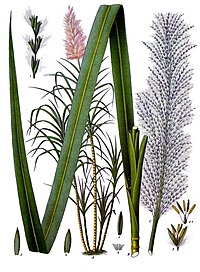
Photo from wikipedia
Sugarcane mosaic virus (SCMV; genus Potyvirus) induces maize dwarf mosaic disease that has caused serious yield losses of maize in China. Cross-protection is one of the efficient strategies to fight… Click to show full abstract
Sugarcane mosaic virus (SCMV; genus Potyvirus) induces maize dwarf mosaic disease that has caused serious yield losses of maize in China. Cross-protection is one of the efficient strategies to fight against severe virus strains. Although many mild strains have been identified, the spontaneous mutation is one of the challenging problems affecting their application in cross-protection. In this study, we found that the substitution of cysteine (C) at positions 57 or 60 in the zinc finger-like motif of HC-Pro with alanine (A; C57A or C60A) significantly reduced its RNA silencing suppression activity and SCMV virulence. To reduce the risk of mild strains mutating to virulent ones by reverse or complementary mutations, we obtained attenuated SCMV mutants with double-mutations in the zinc finger-like and FRNK motifs of HC-Pro and evaluated their potential application in cross-protection. The results showed that the maize plants infected with FKNK/C60A double-mutant showed symptomless until 95 days post-inoculation and FKNK/C60A cross-protected plants displayed high resistance to severe SCMV strain. This study provides theoretical and material bases for the control of SCMV through cross-protection.
Journal Title: Frontiers in Plant Science
Year Published: 2021
Link to full text (if available)
Share on Social Media: Sign Up to like & get
recommendations!